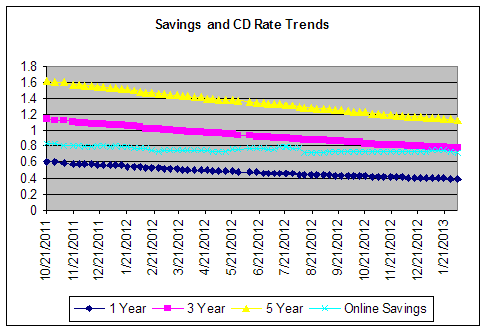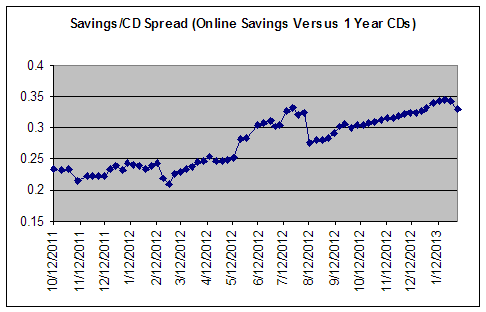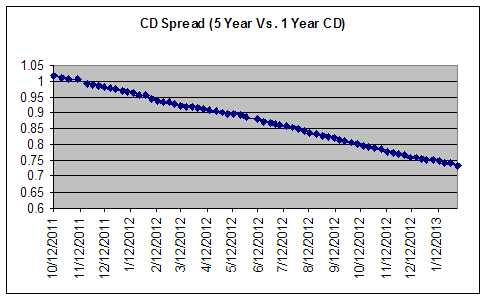Savings rates and CD rates both dropped this week, continuing a five year trend that started after the onset of the global economic crisis. Average one-year CD Rates dipped from .395% to .393% APY. Three year average CD rates dropped from .780% to .776% APY. Five year average CDs dropped to 1.130% APY from 1.135%. Online savings accounts took a sharp drop this past week after staying stable for the past five months, moving from .738% to .724% APY. For online savings accounts, that represents the lowest rate since August 2012.
Five years ago, the top banks on average paid:
- 5% APY on online savings accounts.
- 4% APY for a 12-month CD
- 4% APY for a 36-month CD
- 4.8% APY for a 60-month CD
Times have changed.
Despite drops in the averages last week, the top rates remained the same. This is more important because savers don't deposit money using averages. The top nationally available rates are:
- Savings: Salem Five Direct remained steady at 1.25% APY
- 1 Year CD: CIT Bank at 1.05% APY.
- 3 Year CD: CIT Bank at 1.44% APY
- 5 Year CD: CIT Bank - 1.85% APY.
- Rewards Checking: Hope Community Credit Union - 3.51% APY rewards rate up to $10,000. To learn about reward checking and Hope Community Credit Union read my rate update from last week.
Local banks and credit unions often offer better rates (especially for CDs) than online banks so be sure to check them out. View local CD rates in your area.
The chart below shows the trend in average rates since October 2012.

The difference in the rate of decline between online savings and CD rates can be viewed on the chart below, which shows the spread between online savings account rates and 12 month CDs. After hitting a new high several weeks in a a row, the spread dropped a bit to .343 percentage points last week and then took a steeper drop to .33 percentage points. That's still relatively high. On average, online savings account rates pay .33 percentage points more than 1 year CDs, up from .23 percentage points more at the beginning of last year.

General rate environment
Last week we saw the Yin of the Yang. While the economy seemed to gain some momentum in the previous couple of months, the data from last week confirmed that the growth is slow and not enough to alter the unemployment picture. In fact, according to data last month, the economy unexpectedly shrank last quarter. GDP dropped at a .1% annual rate. The unemployment rate also went in the wrong direction, rising from 7.8% to 7.9%. This is significant because the Fed has stated that it will not raise rates until unemployment falls to 6.5%. The last piece of negative news was the drop in consumer confidence 66.7 to 58.6. The problems in Washington D.C., tax increases, cuts in government spending, and the impact of Hurricane Sandy conspires to make the nation less optimistic.
One positive piece of economic data is that housing prices rose by the most in six years according to the S&P/Case-Shiller index.
None of this changes my forecast that deposit rates will continue to gradually move lower in 2013. My core reasoning includes:
- The Fed has committed to keeping rates exceptionally low as long as unemployment is above 6 1/2 percent. It currently stands at 7.9%. At the current rate of decline, it will take at least 2-3 years to get to 7.9%. If the economy picks up, it could get there sooner.
- The economy has picked up a bit of steam in the last couple of quarters. But GDP growth of 1-2% will not be enough to quickly bring down the unemployment rate. I project steady but moderate economic growth of around 2.5% in 2013, although 2012 ended with negative growth. If growth doesn't rebound in the first quarter of 2013, we have a problem.
- Bank are awash in cash from individuals and corporations and do not need more deposit dollars. Third quarter 2012 FDIC data showed banks had over $9 trillion in deposits, up from $8.5 trillion in the third quarter of 2011. Many banks are having trouble figuring out how to deploy their cash. Part of this is because of lending fears and credit quality and the other part is due to increased governmental oversight.
- Demographic trends are unfavorable. Unfortunately, the United States has entered a demographic slide. As the large baby boom generation ages and retires, this puts a large strain on the country's productivity and spending. I believe that demographics is a general driver of economic development. A young population lifts all boats. An aging will leave quite a few boats stranded and make it difficult for the others. Japan and Europe have even worse demographic problems and their economies reflect that. As China's population ages, look for its growth to ebb. This demographic slide will be a factor for the next ten to twenty years, not stopping growth, but certainly acting as a headwind.
- Government grid-lock over the debt ceiling and sequestration. Gridlock continues and although unlikely the U.S. could begin to default on its obligations if the debt ceiling is not raised. Either way, the partisan bickering does little to establish confidence.
I'd add one other factor. Local, state, and government cuts and tax increases are going to slow the economy. Even if sequestration is avoided, government at all levels is cutting back and raising taxes. At this point, it looks doubtful that businesses and the consumer will be able to make up the difference (especially with rising taxes).
All of this could change in an instant though if an unforseen positive or negative event occurs (Nassim Nicholas Taleb coined this term to describe an event that is a surprise, has a major impact, and if often only understood or explained after the fact). Read my article from several weeks ago on Black Swans and how they impact forecasts.
My bank rate outlook: Savings rates will continue to drift lower for the next 10-16 months before beginning to move higher. How high and how fast they move will depend on the government's ability to stop bickering and resolve their budget and borrowing disputes, the continuation of a recent economic uptick, technological advances, and the ability of Europe to put its woes behind it and resolve its fiscal problems.
Check in every week for a discussion of these factors are changing and how they impact my rate forecast. Feel free to comment with your thoughts below and add any potential Black Swans that may change the course of the economy and rates.
Savings Accounts or CDs?
The data shows that opening a savings account is a better bet than a 1-3 year term CD and I expect this to hold through 2013. Many online banks have raised their savings rates over the past six months while CD rates continue to fall.
So for now, here are my recommendations:
For money you want to keep liquid, go with online savings accounts. They offer better rates than 1-3 year CDs and have shown good rate stability over the past year.
For longer-term money, look to open 4-5 year CDs at local community banks. BestCashCow research has shown that community banks and credit unions offer the most competitive rates on longer-maturity CDs.
I believe this is the best and easiest strategy for keeping your cash liquid and maximizing your savings over the next year.

Make the best of a tough savings situation in 2013
Yields may be low in 2013 but a savvy saver can boost the return with no increase in rate by rate shopping. By shopping around, a saver can earn an extra half to full percentage point. On $100,000, that's $1,000 in extra cash per year. Remember, even in today's environment, there is competition for your cash.
As always, I welcome your thoughts and comments.












Add your Comment
use your Google account
or use your BestCashCow account